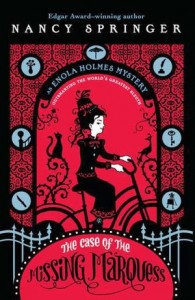 The Case of the Missing Marquess
The Case of the Missing Marquess is the first in the Enola Holmes series. Enola is the much younger sister of Sherlock and Mycroft, who are also minor characters in the book. Enola—born late in her mother’s life—is scandalous due to her very existence. Her mother has allowed her free rein, neglecting her education as far as being an accomplished young lady, but making sure she could read, write, and decipher codes.
When their mother disappears on Enola’s 14th birthday, her brothers decide the girl should attend a strict finishing school. She’s fitted with a corset and other sartorial symbols of a woman’s inferiority. Enola finds messages that her missing mother left for her in code that lead her to a large stash of money her mother has squirreled away for her. Enola packs the money and other valuables into her corset and bustle and runs away. Along the way she finds another runaway and her calling in life.
SPOILER ALERT: Things you might want to know before suggesting this to your kid
Sexism
Enola is a young girl in 1888; sexism is a part of life. Sherlock definitely sees women as the weaker sex and has nothing good to say about their mother who must be irrational and emotionally unstable due both to her age (early 60s) and because she’s female. Enola often quotes Sherlock’s dismissiveness of her “cranial capacity.”
However, in the end, Enola turns all of this on its head. The corset—the ultimate symbol of subjugating women in her mind—saves her life when she’s stabbed (the knife can’t get through the steel ribs) and offers a safe place to store her money. The kidnappers might try to kill her and they definitely go through her pockets, but they won’t search inside her corset.
Enola also realizes that what Sherlock sees as her feminine shortcomings are also her strengths. She notices things that he does not, makes conclusions that he would miss, can go places he cannot. By the end of the book, she’s set up well for her business as a “finder of lost things.”
Societal Restrictions
Women are obviously inferior. Enola’s mother disappears because she’s tired of having her life and possessions owned and controlled by her son. Enola is reminded that she has no say in her life—her brothers can force her into a school to be trained into a proper wife.
However, it’s not just women who face issues. The missing marquess runs away because his mother treats him like a baby—at 12 he still wears his hair in long curls, he’s dressed in the velvet robes of a noble toddler. His mother loves him, but not in a way that allows him to be a full human being.
A major theme of the book is taking control of your own life, regardless of the restrictions that are forced upon you.
Sex
Prostitutes are a feature of the streets of London. Enola is warned that she shouldn’t trust men as a woman out on her own. There’s a tea room only for professional women so they have a place to avoid the predatory men.
Violence
The prologue is dark and scary as an unnamed female character wanders the dangerous streets of London’s East End after dark. Although nothing really happens, there are prostitutes, murders, thieves, and a fear of Jack the Ripper. I was done with the book before I realized that was a flash forward to a later part of the book—I assumed the character wasn’t Enola, so I kept waiting to find out who it was and what happened to her. Honestly, I didn’t think this added much and it got the novel off to an oddly dark start—although I suppose it’s a good warning of later content, and it does contrast well with the epilogue.
Enola is attacked—stabbed (her corset protects her), clothing ripped, grabbed, kidnapped, trussed up and tossed in the bottom of a boat. There she meets the marquess of the title who is a 12 year old boy who ran away and was then kidnapped. She manages to cut through her ropes while also messing up her wrists a bit. The boy, realizing what she’s doing, distracts one of the kidnappers and gets beaten up pretty badly in the process. Enola hits the kidnapper in the head with a rock hard enough to knock him out.
The kidnappers have a lot of control over the East End because everyone is terrified of them. They won’t hesitate to kill those who get in their way.
Poverty
The East End is really rough. People are sick and starving, pickpockets and thieves are everywhere, women sell their bodies, children beg. Specifically, there are old women who drag themselves along the sidewalk, ignored by passersby. In the end, Enola has established herself in London and she disguises herself as a nun to help the unfortunate in the East End—when she sees something that horrifies her, she tries to find a way to make it better.
Language
There’s no swearing or bad language. The writing is a little formal and the vocabulary is a bit advanced. The term “fagged” is used to mean “exhausted.”
Recommendation
I really enjoyed this book and will be recommending it to several 11 year olds I know. The ending is one of the most satisfying I’ve read—it feels right and is the perfect start to the series. Enola is clever and self-sufficient. It’s good for precocious readers who can handle some dark content or perhaps as a read aloud. It’s also a well-written mystery for grownups looking for a quick read.
The Case of the Missing Marquess by Nancy Springer
Published in 2006 by Puffin Books
First in the Enola Holmes Mystery series
Read my daughter’s copy
The Enola Holmes series in order:
The Case of the Missing Marquess
The Case of the Left-handed Lady
The Case of the Bizarre Bouquets
The Case of the Peculiar Pink Fan





Speak Your Mind